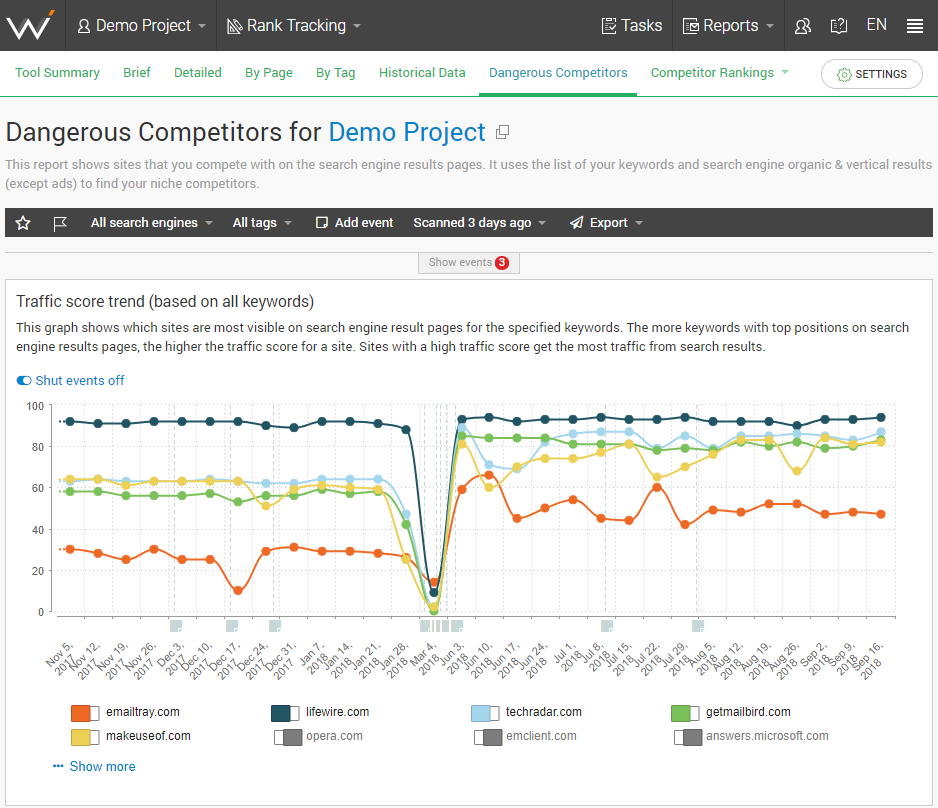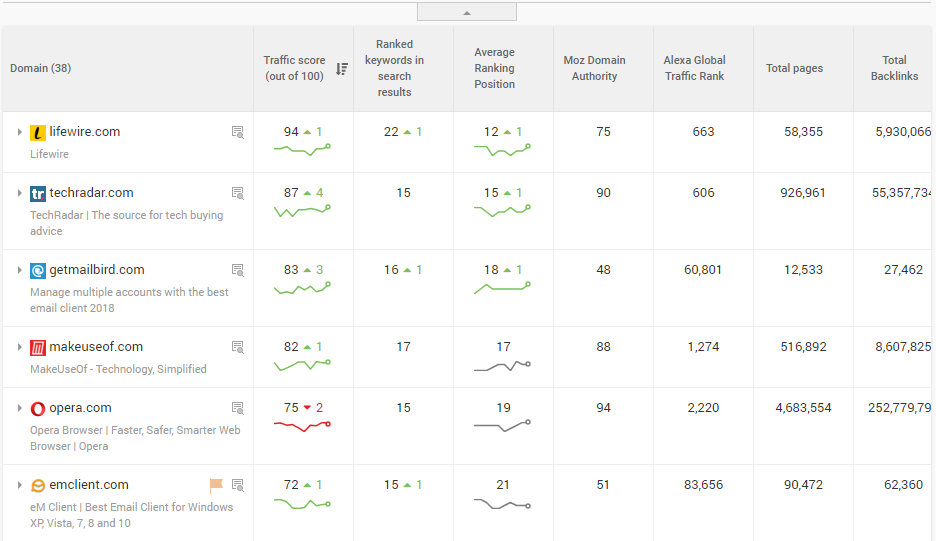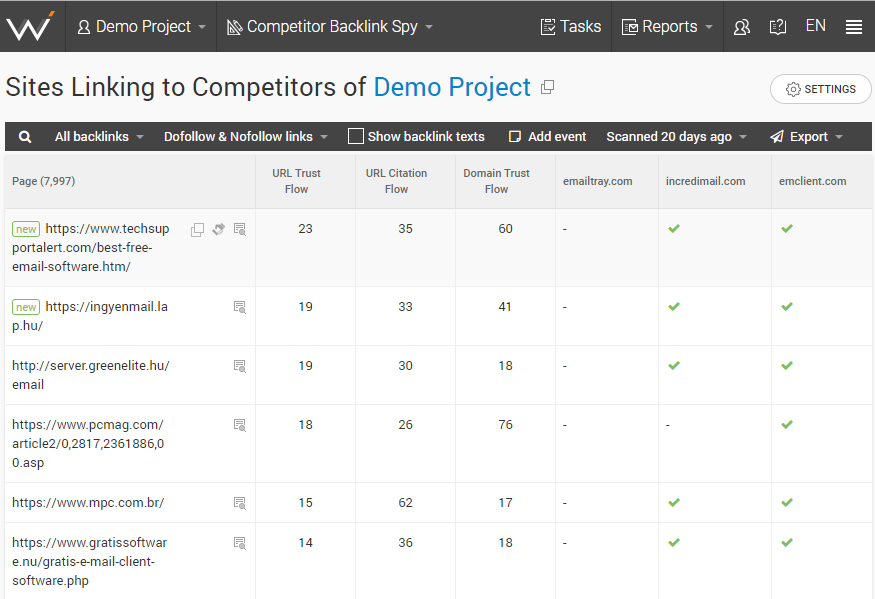
Two SEO facts that everybody knows:
1. Backlinks from reputable sites help you rank in Google;
2. You can find new link building opportunities by spying on your competitors’ backlinks.
If somebody links to sites that share a niche with you, they can be persuaded to place a link to your site, too. Sounds easy in theory, right? But once you actually try it, it turns out to be a complete headache. Link building is hard, folks.
“Who cares if it’s hard? I’m motivated to build links and rank high!”
That’s what I love to hear. Motivation is the foundation of success! Don a black cape and put on your mask. A noble thief who wants to steal competitor backlinks needs two things: charm and SEO tools. Let’s go into detail about how to use each.
1. How to Find Competitor Backlinks with SEO Tools
Before you can go rummaging through your competitors’ link profiles, you need to identify your competitors (obviously). If you don’t know them yet, read on! If you do, consider staying here for a little longer. You might learn how to find more competitors – and more backlinks to steal.
The most optimal way is to use an SEO competitor analysis tools, such as WebCEO’s Dangerous Competitors. As the description of the tool says,
“This report shows sites that you compete with on the search engine results pages. It uses the list of your keywords and search engine organic & vertical results (except ads) to find your niche competitors.”
Input your keywords in the tool’s settings and press Save. If you have used the Rank Tracking section in WebCEO before, the keywords will already be there, and you won’t have to open the settings again. You’ll just need to press Rescan.
The report will be made of two parts: a graph and a table. The graph shows how much traffic your competitors get for the same keywords as yours.
The table shows other information, such as the competitors’ total backlinks and the number of ranking keywords that overlap with yours.
Tip: competitors with a smaller keyword overlap will be easier to beat.
Be warned: not all sites shown in the report will be your direct business competitors. Their services might be very different from yours, but they could still outrank you for your keywords. Choose your competitors from that list wisely – in other words, choose the ones whose audience you want for yourself.
Once you’ve decided on who to compete with, it’s time for a competitor backlink checker to take the stage – WebCEO’s Competitor Backlink Spy. Enter your competitors’ URLs in the settings and start scanning. Once the report is ready, it will show the pages that link to you and to the competitors.
Look for the rows where your competitors have ticks, but your site doesn’t. That’s how you can find domains where your competitors have backlinks and where you might be able to build some of your own. The Competitor Backlink Spy report displays the linking domains’ authority as well, so you’ll know if reaching out to them will be worth the effort.
And now you just add your potential backlink sources in an Excel spreadsheet. There! With that, your link building strategy has tangible goals, and your work is cut out for you.
2. How to Ask for Backlinks with a Noble Thief’s Charm
Next comes reaching out to those sites and convincing them to give you a backlink. But how? Unfortunately, there is no failsafe plan that is guaranteed to produce backlinks. But there is a strategy that has helped many people before and may work for you, too.
Step 1: Create excellent content
Bait is often used to catch thieves. Great content is a special kind of bait that works in reverse.
Why does it work? Because people won’t link to just any dubious page. They’ll be ashamed of themselves if they tell their users to go somewhere shoddy. Save your targets from embarrassment and put on your site a great piece of content.
What counts as great?
- Meaningful: it has a point. If people read it and think “so what?”, it isn’t worthy of a backlink.
- Valuable: it satisfies the needs of the users who read it. If they want information, it’s there; if they have a problem, you have a solution.
- Premium quality: it’s even better than what those sites usually link to.
Mind you, even the highest quality doesn’t guarantee your content will be accepted. What can you do to increase your chances? Make your content useful not just for its readers, but also for the person you’re offering it to.
What exactly does it mean?
Suppose they have a broken link pointing to your competitor. You have content similar to what the competitor had on the other side of that link. Your target would certainly like to fix the broken link on their site. If you offer them your content from that angle, you’ll most likely hear a yes.
Or a different scenario: they have a link pointing to an outdated piece of content by your competitor. If you have something that’s more relevant and up-to-date, that link might be changed if you ask. See the pattern? When giving you a backlink solves someone’s problem, you have a very good chance to get that backlink.
This will be reflected in the emails you can send, the examples of which you can read a bit further down.
Step 2: Connect with your target
Some people have been lucky to get a backlink after asking once, despite having never talked before. However, I think you’ll agree that it’s much better to build a cordial relationship before asking. Friends and even mere acquaintances tend to receive consent more often than strangers.
Where can you connect with your future backlink buddies? Anywhere you can freely talk like equals will do. Facebook, Quora and other major social media platforms; comment sections on their websites and on your own, too; any site you can think of works. Chat them up until you feel you are ready for the next step, which is…
Step 3: Reach out and ask
If you never ask, the answer will always be silence. This is where you are put to the test and judged for being worth your salt. Once preparations have been made, it’s time for you to have a shot at asking for a backlink.
Email outreach is a popular option, but not the only one. Any means of sending a private message (for example, via social media and forums) will do. If anything, if you happen to know what channel your backlink buddy uses most often – use that one to send them a message.
Here are a few examples to inspire you:
Example 1
Hello John!
I’ve been looking through your blog for articles about client outreach and really liked (article’s title). Some of its points were exactly what my marketing strategy had been missing. You’re amazing! I can’t thank you enough for your help.
I’ve also noticed that you talked about outreach templates in that article. I happen to have a post on my blog with examples of the best email outreach templates: (link). I’m sure you’ll like it, so feel free to check it out! Your readers may find it helpful if that part had a link to my post.
Keep up the good work with (your website) and your blog.
Sincerely,
Dave
Example 2
Hi Steve!
I’ve been looking through your blog for articles on client outreach and noticed a broken link in (article’s title).
Judging by the context, it used to lead to a resource about outreach templates, and my blog has a post with exactly that: (link). If you find it a good alternative, would you consider linking to me instead? I’m sure it will be up to your standards.
Best regards,
Mary
Example 3
Hey Laura,
I’ve been looking through your blog for articles on SEO and noticed a link pointing to (another site) in your post (title). Their article appears to be outdated: it recommends using obsolete techniques like writing in the <meta keywords> tag and even harmful ones like keyword stuffing.
I happen to have a more up-to-date post on the same subject on my blog, titled (post’s title). Would you consider linking to it instead of the other article? Here’s the link if you are interested: (link).
Best wishes,
Kate
Can you see the key points? Let’s sum them up:
- Write as you’d write to a person. It sounds like it goes without saying, but it can be harder than you think! Be careful not to write up a cold, impersonal email that reads like an obvious template.
- Show interest in their work. It’s a nice way to close distance when it’s your first time writing to that person. You won’t instantly graduate from a stranger, but you’ll score some points if you show you are familiar with their website and its content.
- Make it mutually beneficial. As was said earlier in this post, people like it when the deal isn’t one-sided and benefits them in some way, too. Say what they have to gain by giving you a link.
Be aware, though: not all will accept your offer or even reply. But those who will, no matter how few, will be a tremendous help. So if you want to get more backlinks, you need to cast a really wide web and befriend a lot of people. Turn up your charm up to eleven!
Is your motivation still strong? Then there’s no time to waste. Find your competitors and break into their link profiles. They’ll never see it coming.






